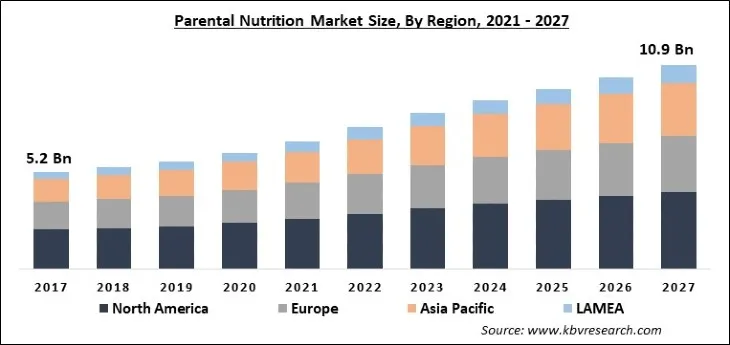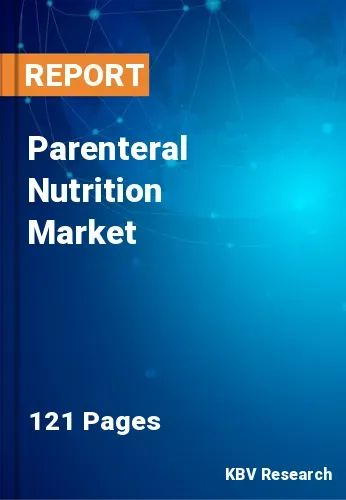The Global Parenteral Nutrition Market size is expected to reach $10.9 billion by 2027, rising at a market growth of 8.1% CAGR during the forecast period. Parenteral nutrition (parenteral nutrition), or intravenous feeding, provides liquid nutrients such as proteins, vitamins, fats, electrolytes, minerals, and carbohydrates. It is a component of specialized nutritional therapy that renders nutritional support to patients who are not able to use their gastrointestinal tract properly. It is extremely helpful in eliminating malnutrition and maintaining hydration, energy, and strength levels. Due to this, it is broadly utilized among patients who are suffering from cancer, hydration, Crohn’s disease, ischemic bowel disease, short bowel syndrome, and abnormal bowel function.
The development of the parenteral nutrition market is expected to be fueled by the surge in the occurrence of malnutrition among children, mainly in the emerging and under-developed nations around the globe. Additionally, the requirement for parenteral nutrition (parenteral nutrition) to appropriately balance amino acids, lipids, vitamins, minerals, and other nutrients would create bright growth prospects for the growth of the parenteral nutrition market.
The adoption of parenteral nutrition is expected to fuel as it reduces the chances of underdevelopment and infection. Very-Low-Birth-Weight (VLBW) newborns are witnessing a huge demand for parenteral nutrition products due to the low possibility of Enteral Nutrition (EN). Additionally, a surge in the acceptance of parenteral nutrition for premature infants that results in better neurological growth enhanced intrauterine nutrient deposition, and lower chances of complications, hence enhancing their possibility of survival.

The outbreak of the COVID-19 pandemic has substantially boosted the adoption rate of parenteral nutrition to offer the required nutrition and fluids needed by the body for rapid and safe recovery. In addition, the increasing acceptance of the administration of nutrition by the parenteral medium as compared to enteral feeding among the patients suffering from the COVID-19 for fulfilling the required nutritional needs, rising nutrient absorption, and declining infection risk is expected to accelerate the demand & growth of the overall parenteral nutrition market in the upcoming years.
Moreover, the rising adoption of these formulations among the clinicians for assisting the patients to fulfill their target nutrition consumption, enhance recovery, and cut down the hospital stays are some of the factors propelling the development of the global parenteral nutrition market.
In addition, the governments of numerous countries are undertaking various initiatives with an aim to cut down the growing burden of malnutrition, hence increased the intravenous feeding demand. Various government organizations such as Action against Hunger, Food4Africa, Heifer International, and World Health Organization are willing to take new initiatives that aim to offer better treatment for malnourished individuals.

Various kinds of diseases like head & neck cancer, esophageal cancer, Crohn's, ulcerative colitis, gastric cancer, and laryngeal cancer can have an impact on oral food consumption among the patients. Due to their increasing occurrence, the global parenteral nutrition market is expected to be propelled in the upcoming years.
The preference toward enteral nutrition is constantly increasing among patients across the globe. Medical specialists generally suggest the use of enteral feeding in comparison to parenteral feeding. This is due to the fact that it is less expensive, can be easily administered, and have fewer complications. Moreover, enteral feeding enables better and effective nutrient consumption and supports the natural healing process of the body through the stimulation of the intestinal blood flow.
Based on Nutrient Type, the market is segmented into Single Dose Amino Acid Solution, Parenteral Lipid Emulsion, Carbohydrates, Trace Elements, and Vitamins & Minerals. The parenteral lipid emulsion segment would exhibit the fastest growth rate during the forecasting period. Growing occurrences of hospital malnutrition is the main factor boosting the demand for parenteral lipid emulsions in giving non-protein calories and essential fatty acids in patients, decreasing inflammation, and enhancing metabolic & clinical outcomes. Additionally, the demand of the segment in hospitals would be boosted by the increasing demand from severely suffering patients and the high rates of chronic diseases such as inflammatory bowel disease, cancer, and diabetes.
| Report Attribute | Details |
|---|---|
| Market size value in 2020 | USD 6.2 Billion |
| Market size forecast in 2027 | USD 10.9 Billion |
| Base Year | 2020 |
| Historical Period | 2017 to 2019 |
| Forecast Period | 2021 to 2027 |
| Revenue Growth Rate | CAGR of 8.1% from 2021 to 2027 |
| Number of Pages | 121 |
| Number of Tables | 190 |
| Report coverage | Market Trends, Revenue Estimation and Forecast, Segmentation Analysis, Regional and Country Breakdown, Companies Strategic Developments, Company Profiling |
| Segments covered | Nutrient Type, Region |
| Country scope | US, Canada, Mexico, Germany, UK, France, Russia, Spain, Italy, China, Japan, India, South Korea, Singapore, Malaysia, Brazil, Argentina, UAE, Saudi Arabia, South Africa, Nigeria |
| Growth Drivers |
|
| Restraints |
|
Based on Regions, the market is segmented into North America, Europe, Asia Pacific, and Latin America, Middle East & Africa. Asia-Pacific would display the fastest growth rate during the forecasting period. The regional market is expected to be boosted by the economic growth in different nations like India, Japan, and China and the supportive government initiatives along with the favorable reimbursement policies and growth of the healthcare industry. Additionally, the surge in the occurrence of chronic diseases, the rising awareness regarding the advantages of the nutrient types, and the growing number of parenteral nutrition users in some of the emerging countries of this region would create new growth avenues for the players operating in the regional parenteral nutrition market over the forecast years.
Free Valuable Insights: Global Parenteral Nutrition Market size to reach USD 10.9 Billion by 2027
The market research report covers the analysis of key stake holders of the market. Key companies profiled in the report include Vifor Pharma Management Ltd., Baxter International, Inc., Allergan PLC (AbbVie), B. Braun Melsungen AG, Fresenius SE & Co. KGaA, Grifols S.A., Pfizer, Inc., ICU Medical, Inc., Anhui Medipharm Co., Ltd. and Aculife Healthcare Private Limited.
By Nutrient Type
By Geography


The parenteral nutrition market size is projected to reach USD 10.9 billion by 2027.
The surge in the rate of malnutrition among the global population are driving the market in coming years, however, increasing inclination toward enteral nutrition limited the growth of the market.
Vifor Pharma Management Ltd., Baxter International, Inc., Allergan PLC (AbbVie), B. Braun Melsungen AG, Fresenius SE & Co. KGaA, Grifols S.A., Pfizer, Inc., ICU Medical, Inc., Anhui Medipharm Co., Ltd. and Aculife Healthcare Private Limited.
The expected CAGR of the parenteral nutrition market is 8.1% from 2021 to 2027.
Yes, The outbreak of the COVID-19 pandemic has substantially boosted the adoption rate of parenteral nutrition to offer the required nutrition and fluids needed by the body for rapid and safe recovery.
The North America emerged as the leading region by acquiring the maximum revenue share of the global parenteral nutrition market in 2020.
Our team of dedicated experts can provide you with attractive expansion opportunities for your business.

